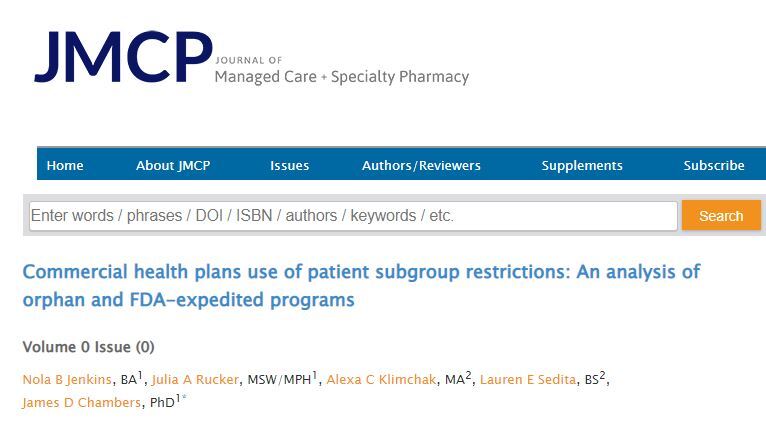Journal: Journal of Managed Care + Specialty Pharmacy
Citation: Jenkins NB, Rucker JA, Klimchak AC, Sedita LE, Chambers JD. Commercial health plans use of patient subgroup restrictions: An analysis of orphan and FDA-expedited programs. J Manag Care Spec Pharm. 2023 Mar 2:1-8. doi: 10.18553/jmcp.2023.22363. Epub ahead of print. PMID: 36864544.
ABSTRACT
Background: Health plans apply utilization management criteria to guide their enrollees’ access to prescription drugs. Patient subgroup restrictions (ie, clinical prerequisites for drug coverage) are a form of utilization management that have not been thoroughly investigated.
Objective: To examine the frequency with which large US commercial health plans impose patient subgroup restrictions beyond the US Food and Drug Administration (FDA) label in their coverage policies for orphan drugs and for drugs included in 1 or more FDA-expedited programs. To determine how consistently these patient subgroup restrictions align with eligibility criteria specified in each drug’s pivotal clinical trial(s).
Methods: The Tufts Medical Center Specialty Drug Evidence and Coverage (SPEC) database was used, which includes coverage policies issued by 17 large US commercial health plans. SPEC contained 3,786 orphan drug policies and 4,027 FDA-expedited drug policies (current as of December 2020). SPEC data on plans’ patient subgroup restrictions were assessed for the first objective. Each patient subgroup restriction was benchmarked against the corresponding eligibility criteria for a drug’s pivotal clinical trial(s) for the second objective. To do so, the “Clinical Studies” section of the drug’s FDA label was reviewed or, if necessary, the published manuscript describing the drug’s pivotal trial(s). Patient subgroup restrictions were categorized as follows: (1) “consistent,” the restriction and trial eligibility criterion are equivalent; (2) “same measure, more stringent,” the restriction and trial eligibility criteria depend on the same measure, but the plan coverage is more restrictive; (3) “same measure, less stringent,” the restriction and trial eligibility criteria depend on the same measure, but the plan coverage is less restrictive; and (4) “not consistent,” the restriction and trial eligibility criteria depend on different measures.
Results: Health plans imposed patient subgroup restrictions in 20.2% of orphan drug policies (frequency varied by health plan, 11.7%-36.6%), and in 21.8% of FDA-expedited drug policies (frequency varied by health plan, 11.1%-47.9%). Of the 936 patient subgroup restrictions in orphan drug policies, 60.3% were categorized as consistent; 7.3% as same measure, more stringent; 12.0% as same measure, less stringent; and 20.5% as not consistent. Of the 1,070 patient subgroup restrictions in FDA-expedited drug policies, 57.5% were categorized as consistent; 6.7% as same measure, more stringent; 16.0% as same measure, less stringent; and 19.8% as not consistent.
Conclusions: Patient subgroup restrictions for orphan drugs and FDA-expedited programs varied substantially across health plans, potentially resulting in inconsistent access to a given therapy across the approved patient population. Patient subgroup restrictions tend to be consistent with eligibility criteria specified in pivotal clinical trials.

